Cruelty that humans sometimes exhibit to wildlife including our closest living relatives in the animal kingdom, the great apes, is always devastating to see. Here in Borneo we occasionally confront… Continue reading In Our Hands: A Wild Orangutan Male Rescued with Severe Injuries
In Our Hands: A Wild Orangutan Male Rescued with Severe Injuries



